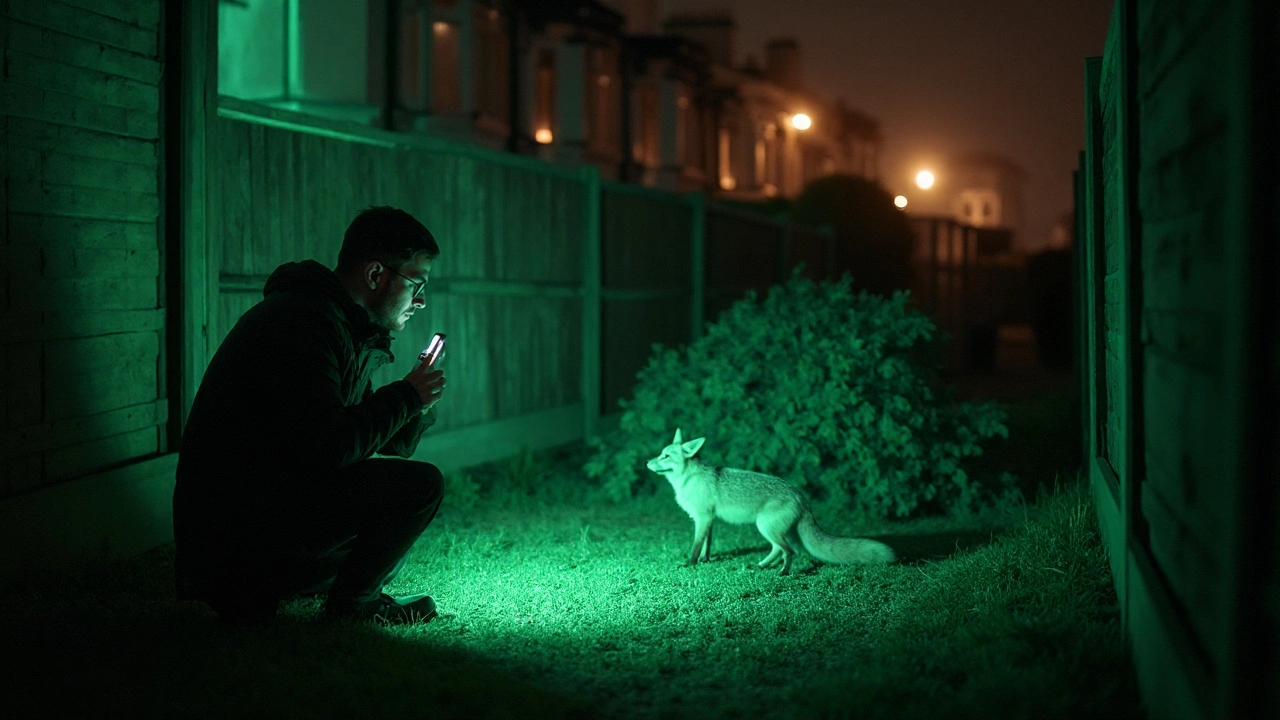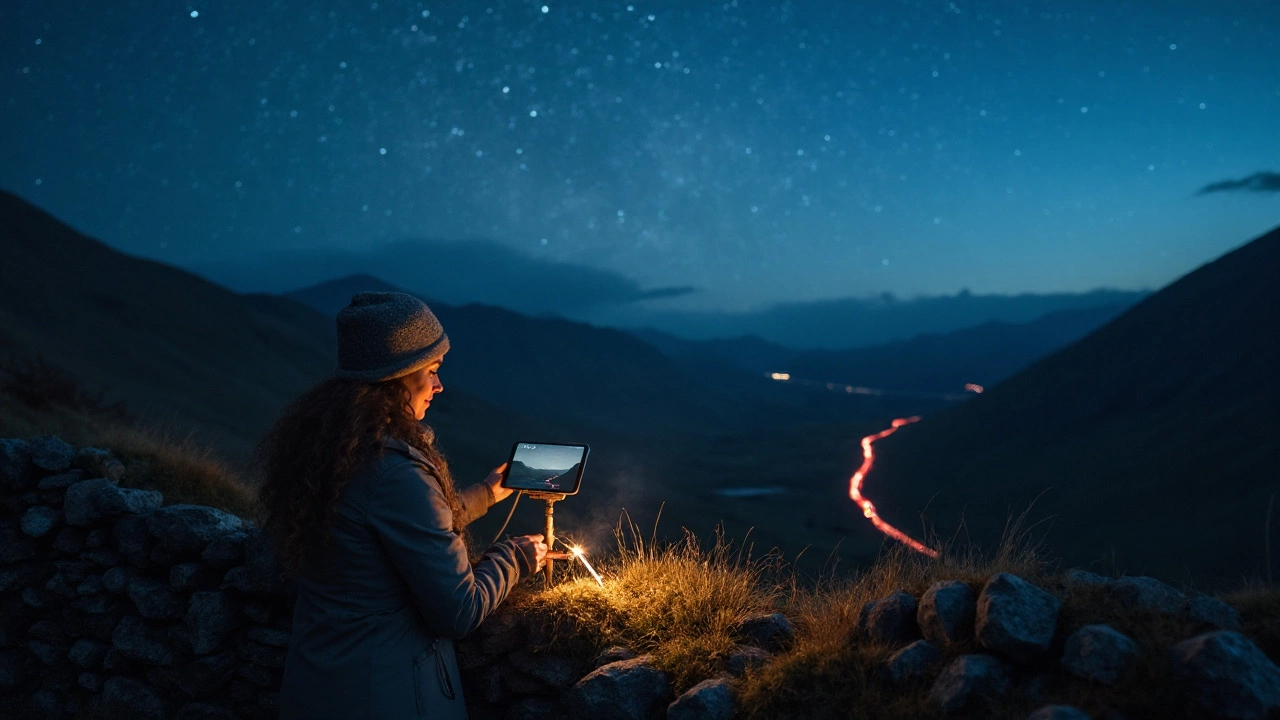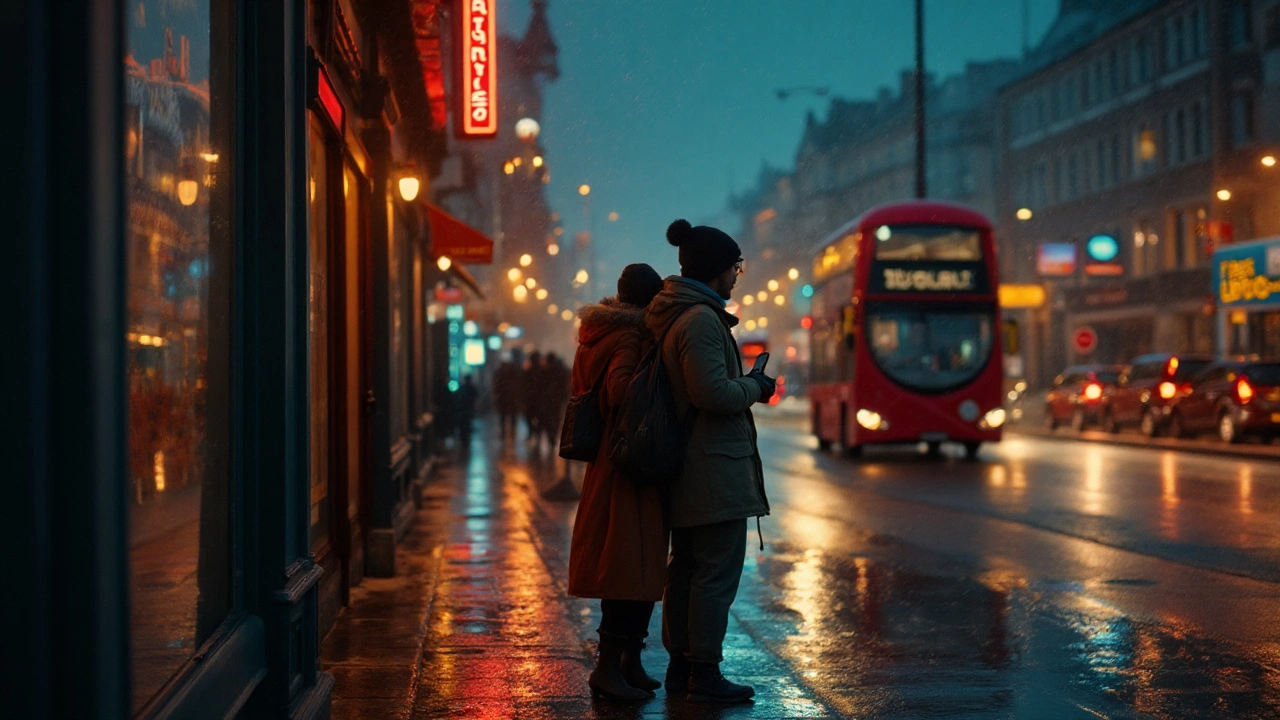Short answer: phones do not have true night vision. They cannot see in complete darkness the way a thermal imager or military night‑vision goggle can. What they do have is smart software that squeezes every last photon out of dim scenes. If there is zero light, a phone will show zero detail unless you add light, usually infrared from an external illuminator.
Here is the quick take so you can make a call with confidence.
- Smartphones need some light. Night mode stacks multiple frames and denoises, but it cannot create detail from pitch black.
- True night vision uses infrared or thermal. Most phones block near‑IR for color accuracy, and phones do not sense heat.
- You can rig a phone to work in darkness using an external 850 or 940 nm IR light and a camera app that does long exposures or video, but range and motion blur are limited.
- For night security, a dedicated camera with built‑in IR LEDs will beat a phone on range, reliability, and motion clarity.
- If you want creative near‑IR photos, you need a modified sensor or a clip‑on accessory; stock phones only leak tiny amounts of IR.
What phones actually do at night versus real night vision
When you tap Night mode on an iPhone 15 Pro, Google Pixel 8, or Samsung Galaxy S24, you are not switching on an IR sensor. You are asking the phone to take a rapid burst of frames at different exposures, align them, and merge them. Google calls this multi-frame super-resolution and has explained it in depth on their AI blog for Night Sight. Apple documents a similar pipeline in its developer notes, and DxOMark’s lab tests show the trade-off between brightness, noise, and motion blur. The short version: the phone combines many short, noisy frames into one cleaner image.
Why it works: modern sensors from Sony and Samsung have larger pixels, backside illumination, and clever readouts. Computational photography then denoises, sharpens, and even hallucinates texture using learned priors. It is impressive, but it is not magic. If no photons hit the sensor, there is no signal to work with.
Now compare that to true night vision. There are two big families:
- Near-infrared night vision: An image intensifier tube or a camera sensor sees near‑IR light, usually 850 or 940 nm. Security cameras flood the scene with invisible IR LEDs, then capture the reflected IR. Result is crisp black‑and‑white, often with bright eye shine on animals. If the IR LEDs are off, range falls fast.
- Thermal imaging: A microbolometer measures heat radiation around 8 to 14 micrometers. It works in total darkness, fog, or smoke because it is sensing heat, not reflected light. Thermal add‑ons like FLIR and Seek clip to phones, but your phone by itself cannot do this.
Most phones deliberately block near‑IR with a hot mirror filter. That keeps your daytime photos from looking muddy. Some phones leak a tiny bit of near‑IR, which is why a TV remote can look like a faint white blink in your camera view. But that leak is not enough to act like a proper IR camera.
So when is a phone fine at night? City streets, dim bars, campfires, and moonlit landscapes. When is it not fine? Unlit sheds, backyards after the porch light is off, wildlife in the scrub, or any scene with action you want to freeze. Without light, the phone stretches exposure time, and moving people smear into ghosts.
I live in Adelaide, and I love shooting at the coast at twilight. On a clear night at Henley Beach, a Pixel or iPhone will give you a dreamy, bright scene if you hold steady for a few seconds. Walk into a pitch-dark shed in the Hills with zero spill light, though, and you will get a black frame unless you bring a torch or IR.
| Tech | Works in zero light | Night color | Motion clarity | Typical range at night | Typical cost (AUD) | Best use | Notes |
|---|---|---|---|---|---|---|---|
| Smartphone Night Mode (2023-2024 flagships) | No (needs ambient light) | Sometimes, with enough light | Low to medium; blur with movement | Up to street width if lit; near zero in darkness | Already owned | Social, travel, city night scenes | Computational stacking; limited by light and motion |
| Security Camera with IR LEDs (850 or 940 nm) | Yes (uses built-in IR) | Black and white | Medium; optimized for motion detection | 10-30 m depending on model and IR power | 80-400 | Home security, wildlife watching | Some 850 nm LEDs glow faint red; 940 nm are covert but lower range |
| Thermal Camera (phone add-on) | Yes (senses heat) | False color palette | Medium; depends on sensor resolution | 10-100 m for humans | 300-800 | Search, inspection, wildlife detection | Sees heat differences, not visible detail or faces |
| Night Vision Goggles/Monocular (Gen 2+/3) | Yes (intensifies low light; often with IR) | Green or B and W phosphor | High; designed for movement | 50-200 m depending on ambient light | 2,000+ | Navigation, surveillance | Regulated in some regions; fragile and expensive |
Sources for the comparisons include manufacturer white papers from Sony and Apple, Google’s Night Sight posts, DxOMark sensor and camera tests, and reviews in IEEE Spectrum on computational photography trends.

How to get better low-light shots with your phone
If you want your phone to punch above its weight at night, the way you shoot matters as much as the hardware. Here is a field‑tested approach that works on iPhone, Pixel, Samsung, and most Androids.
- Stabilize first. Brace against a wall, rest the phone on a railing, or use a tiny tripod. Even a folded hoodie under the phone helps. Avoid hand‑holding at arm’s length.
- Use the main wide camera. Skip the ultra‑wide or telephoto at night unless you have to. The main lens has the largest sensor and usually has optical stabilization.
- Turn on night mode, then ride the exposure. Tap to focus, then drag the exposure slider down a notch. Slight underexposure reduces noise and preserves detail you can lift later.
- Use a timer. Even a 3‑second self timer prevents your tap from shaking the first frame.
- Shoot multiple frames. Take 3 to 5 shots of the same scene. Minor hand jitter gives the algorithm extra data. Pick the cleanest later.
- Keep people still or add a touch of light. To freeze a walking person, you need a faster shutter, which means more light. A quick bounce from your flashlight off a wall can do wonders.
- Mind mixed light. LED streetlights can flicker or tint weirdly. If colors look off, switch to black and white in edit and focus on shape and contrast.
- Go RAW if your phone supports it. ProRAW, RAW 12‑bit, or HDR RAW keeps more latitude for noise reduction and color in Lightroom or Snapseed.
- Clean the lens. A greasy smear multiplies halos around point lights at night.
- Use 4:3 aspect ratio. It uses the full sensor. Cropping to 16:9 throws away pixels you need in the dark.
Rules of thumb that save shots:
- If your subject moves, avoid long Night mode exposures. Switch to standard Photo, slightly raise ISO, take a burst, and pick the least blurry frame.
- Do not digitally zoom in the dark. Walk closer or crop later. Digital zoom amplifies noise fast.
- Set white balance manually if you can. Sodium lamps, LEDs, and neon all cast strange hues. A fixed Kelvin setting keeps skin from turning alien green.
- Watch reflections through windows. IR from your own phone or nearby cameras bounces straight back at the glass, painting the scene with glowing rings. Shoot with the lens tight to the glass and throw a dark cloth over the phone to cut reflections.
Want to see in actual darkness with a phone? You need to add light. Here are safe, practical options.
- Carry a small torch and bounce it. Aim it at the ground or a wall to create soft fill without blinding people.
- Use an external 850 nm IR illuminator and switch to a monochrome camera app. Many phones will pick up a little IR for video at close range, but range is limited and quality varies by model. If you want consistent IR performance, a dedicated security camera is better.
- Clip‑on thermal camera. If your goal is to find a warm dog in the backyard at 2 am, a thermal add‑on is the easiest and most reliable option.
If you are the tinkering type, there is near‑IR photography. Some photographers remove or replace the factory IR‑cut filter to shoot 720 nm or 850 nm images for surreal foliage and dark skies. That is a permanent mod and will void warranties. On unmodified phones, you can mimic the look with filters and editing, but it will not be the same as true IR capture.
Safety note you should not skip: high‑power IR sources can be hazardous at very close range because you cannot see the brightness to blink. Avoid pointing IR lasers at eyes, keep LED IR arrays away from babies and pets at short distances, and follow the manufacturer’s exposure limits.
Quick checklist you can screenshot before a night shoot:
- Stabilize, timer on, main lens only
- Night mode on, exposure nudged down
- Tap to focus, lock focus if your phone allows
- Shoot a short burst, review, reshoot if you see blur
- Add light for people or action, even a tiny bit
- Switch to black and white if colors fight you

Using a phone as a night security camera: when it works and what to watch
Repurposing an old phone for night monitoring is smart, cheap, and quick to test. It just has limits. Here is how to set it up well and where it falls short compared to a purpose‑built camera.
What works:
- Indoor rooms with some ambient light from a nightlight, aquarium, or streetlight.
- Short‑range monitoring near a doorway with a small lamp or motion‑triggered light.
- Temporary setups, like watching a 3D printer or a pet crate overnight.
What fails fast:
- Backyards or sheds with no light. Without IR illumination, your phone sees black.
- Fast motion. Night mode smears moving people. You will get a bright blur where a face should be.
- Weather and durability. Phones hate condensation, dust, and big temperature swings.
How to set it up well in 10 minutes:
- Power and mount: Keep the phone on mains power and mount it securely. Aim slightly downward to avoid capturing sky glare.
- Use a monitoring app: Choose a camera app that streams to your other device or the cloud and supports motion alerts and zones. Set a notification schedule so your phone does not ping all night for moths.
- Add light: If you can, put in a low‑watt smart bulb on a motion trigger. If you cannot add visible light, try a 940 nm IR illuminator pointed across the scene at an angle to avoid backscatter into the lens.
- Lock exposure and focus if possible: Prevent the app from hunting and pumping brightness up and down.
- Test at night: Walk the path you care about. Check if faces are identifiable, not just blobs. Adjust angle, distance, and light based on that test.
Decision guide for the right tool:
- If you need to identify faces beyond 5 to 7 meters in darkness, get a dedicated security camera with strong IR and a larger sensor.
- If you only need to know that someone is there at 10 to 20 meters, a thermal add‑on will show the person, not the face.
- If you just need a notification and a rough clip near the door, a phone plus a small light is fine.
Legal and privacy basics in Australia you should know: public places are generally fine to record video, but audio recording is more restricted. On private property, you can monitor your own space, yet pointing cameras into a neighbour’s yard or through windows can breach state surveillance laws. In South Australia, the Surveillance Devices Act limits the installation and use of optical surveillance devices to observe private activities without consent. Post a simple notice if you have cameras around entryways, aim them at your property, and avoid audio unless you have a legitimate reason. If you rent, check your lease and strata rules. This is general guidance, not legal advice.
Practical pitfalls to avoid at night around the home:
- Glass reflections: IR bounces. Do not put a phone behind a window and expect IR to work; you will light up the glass. Move the camera outside or turn off IR and add visible light.
- Backlighting: A bright streetlight behind a person will force your phone to expose for the light, turning people into silhouettes. Angle the camera so the bright source is out of frame.
- Bandwidth: Night footage is noisy and heavy. On older Wi‑Fi, your stream may stutter. Reduce resolution or frame rate in the app.
- Overheating: A phone on charge, streaming video, in a warm cupboard will cook. Give it airflow.
Mini‑FAQ you are probably about to ask:
- Can my phone see infrared from a TV remote? Yes, as faint white flickers. That is not enough for proper IR night video.
- Do any phones have built‑in IR night cameras? Mainstream models do not. Some niche devices for industry include thermal sensors, but that is different tech.
- Can I remove the IR filter in my phone? Technically possible but not practical for most people. You will ruin color photos and likely the phone. Better to use a dedicated IR‑sensitive camera.
- Is IR safe for babies and pets? The low‑power IR LEDs on consumer cameras are considered eye‑safe at normal distances. Avoid close‑range, prolonged exposure, and do not use IR lasers around eyes.
- Why are my window night videos just bright snow? You are seeing IR reflecting off dust and the glass itself. Move the camera, add external IR from an angle, or turn off IR and use visible light.
- What is color night vision on some cameras? It is marketing for cameras that keep color in very low light using large sensors and fast lenses. In true darkness they still switch to black and white with IR.
Troubleshooting quick hits by symptom:
- Everything is blurry: Shorten your exposure by adding light or using standard Photo mode. Stabilize better.
- Faces are mushy: Move the camera closer, switch to the main lens, reduce digital zoom, and add a small fill light near face height.
- Video keeps pulsing bright and dark: Lock exposure or reduce dynamic range by reframing to keep bright lights out.
- App drains battery overnight: Keep the phone on charge and limit FPS or resolution in the app settings.
- Wildlife avoids the camera: Swap 850 nm IR for 940 nm to reduce the visible red glow that some animals notice, and move the illuminator off‑axis.
If you want to go deeper into the tech, look up sensor signal‑to‑noise ratio curves in Sony IMX white papers, Apple’s documentation on Night mode and Deep Fusion, Google’s research blog on Night Sight, and independent lab measurements from DxOMark. They all line up with what you will see in the field: phones are fantastic in low light, not magic in no light.

